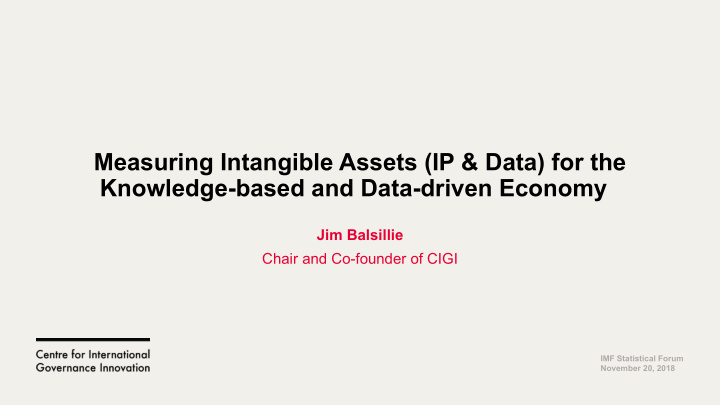



Measuring Intangible Assets (IP & Data) for the Knowledge-based and Data-driven Economy Jim Balsillie Chair and Co-founder of CIGI IMF Statistical Forum November 20, 2018
Big Data, Artificial Intelligence and Machine-learning Challenges 1. The implications of “winner take all” economics and emergence of a new factor of production – machine knowledge capital – for market frameworks; 2. The implications of increased concentration of wealth for distributional equity and the integrity of democratic process; 3. New risks to national security; and 4. The unleashing of new strategic rivalries in geopolitics.
USPTO – Patent Filings Patent Cooperation Treaty – Patent Filings PCT Applications Filed Source: http://www.wipo.int/pct/en/3million/index.html “Patents are the most concrete and comparable measure of innovative output over countries and time.” The IT Revolution and the Globalization of R&D (http://www.nber.org/papers/w24707)
Economy of Traditional, Tangible Goods Economy of Ideas, Intangible Goods Ownership of physical property is a positive right Owning (“generating”) intellectual property is a negative right Production and sale of physical property to generate revenue Amassing IP and restricting use to collect “rents” The objective in industrial/services economy is to move inventory The objective in the innovation economy is to acquire IP Traditional goods can only be owned by one person at one time IP is globally and simultaneously accessible by an unlimited number of (“rivalrous”) people (“non-rivalrous”) Traditional infrastructure needed to move goods across borders to IP is impossible to determine where it originates and how it moves individual customers across borders Supply chains feature multiple vendors competing with each other Value chains are based on winner-take-all economics based on cost competitiveness Competition rules prevent traditional production monopolies IP is a government created temporary monopoly Trade liberalization increases competition and reduces prices Stronger IP protections decrease competition and increase prices Traditional trade agreements reduce the value of vested interests “Asset Enhancement Agreements” raise the value of vested IP-based interests
Data Governance: Cross-cutting Issues Data Property Rights Social Good • Who owns the data and what do these • What are the mental health issues, especially for data rights entail? youth, from surveillance capitalism? • Who is allowed to collect what data? • How do we protect citizens, but especially vulnerable groups, from this? • What are the rules for data aggregation? • How do we use surveillance for legitimate public • What are the rules for data transfer? safety purposes but not abused to undermine democratic rights & freedoms? • How do we enhance regulation and monitoring of political messaging and advertising? Cyber Security • Who owns the data and what do these data rights entail? • Who is allowed to collect what data? • What are the rules for data aggregation? Global Governance • What are the rules for data transfer? • What should the international rules be governing trade of data? • How are diverse sovereign choices supported? Commercial Potential • How is the flexibility preserved to allow on-going innovation and proper utilization? • How can data strategies better support innovation outcomes? • Is it too soon to encode data provisions in international trade agreements? • What are the individual firm and collective capacities needed to capitalize on this? • How to establish and enforce new global cyber norms? • How to select industries and sectors to support?
Cyber Dimensions of Complexity
Geopolitics of Data Governance EUROPE Strategic Regulations USA CHINA Open Data Flows National Firewall National Champions National Champions “The rapid development of artificial intelligence [AI] will profoundly change human society and life and change the world...AI brings new opportunities for social construction…AI is a disruptive technology with widespread influence that may cause: transformation of employment structures; impact on legal and social theories; violations of personal privacy; challenges in international relations and norms; and other problems. It will have far-reaching effects on the management of government, economic security, and social stability, as well as global governance.” China’s New Generation Artificial Intelligence Plan released in 2017 (as translated)
Strategic Technologies and AI Nationalism
Trade Liberalization vs. Inward FDI Impact on the Population of Firms “In the knowledge-based and data-driven economy, FDI of the M&A type tends to target the most innovative, fastest growing firms with the potential to become ‘gazelles’. Such FDI expatriates the key assets, including IP and often key personnel, and thus reduces the host country’s stock of rent-generating knowledge capital and its innovative potential. Where trade liberalization takes out the least productive firms, FDI into the innovation economy takes out the most promising, leaving the host country with the ‘mediocre middle’.” Dan Ciuriak A New Name for Modern Trade Deals: Asset Value Protection Agreements by Dan Ciuriak – (2017) CIGI “New Thinking On Innovation”
Future of Work Implications for Social Policy • Greater provision of publicly provided services (education, transport) • More lifelong learning with corresponding shift in its financing • Reform savings and pension systems • Underpinned by a universal basic income? • All financed by shift in taxation on economic rents
Elephant Curve of Global Inequality The vertical axis shows the total real income growth between 1980 and 2016 for each percentile of the global distribution of income per adult. The bottom 10 percentiles are excluded as their income levels are close to zero. The top 1% is divided into smaller groups (up to the top .001%) so as to better account for its share in total global growth captured. Source: WID.world Source: Alvaredo et al. 2017. “The elephant curve of global inequality and growth”. WID.world Working Papers 2017/20.
Policy Framework for the Knowledge-based, Data-driven Era Cyber Security Capture Economic Value Sovereignty (Ethics, Democracy, Privacy) National Security Carve-out Expanded GATS/FTA Compliance
Thank You.
Recommend
More recommend